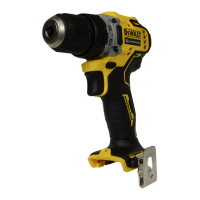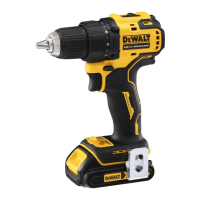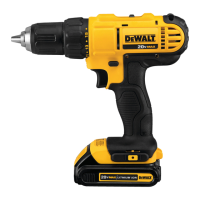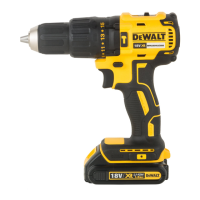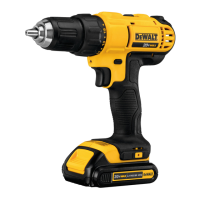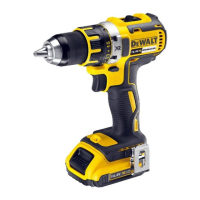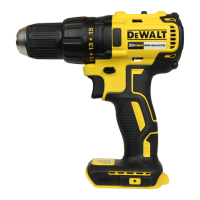12
ENGLISH
Screwdriving
Your tool has a clutch with adjustable torque for driving
and removing a wide array of fastener shapes and sizes. The
numbers on the mode selection collar
6
are used to set a
torque range for screwdriving. The higher the number on the
collar, the higher the torque and the larger the fastener which
can bedriven.
1. Turn the mode selection collar
6
to the desiredposition.
Refer to Mode Selection.
2. Pull the trigger switch applying pressure in a straight line
with the bit until the fastener is seated at the desired depth
in theworkpiece.
Recommendations for Screwdriving
• Start with lower torque settings, then advance to higher
torque settings to avoid damage to the workpiece
orfastener.
• Make some practice runs in scrap or on unseen areas of the
workpiece to determine the proper position of the mode
selectioncollar.
Drilling
1. Turn the mode selection collar
6
to the drillsymbol. Refer
to ModeSelection.
2. Place drill bit in contact with theworkpiece.
NOTE: Use sharp drill bitonly.
3. Pull the trigger applying pressure in a straight line with the
bit until it reaches the desireddepth.
WARNING: Drill may stall if overloaded causing a sudden
twist. Always expect the stall. Grip the drill firmly to control
the twisting action and avoidinjury.
4. Keep the motor running when pulling the bit back out of a
drilled hole to preventjamming.
Recommendations for Drilling
• When drilling, always apply pressure in a straight line with
the bit, but do not push hard enough to stall the motor or
deflect thebit.
• IF THE DRILL STALLS:
- RELEASE TRIGGER SWITCH IMMEDIATELY, remove
drill bit from work, and determine cause ofstalling.
- DO NOT DEPRESS TRIGGER SWITCH ON AND OFF
IN AN ATTEMPT TO START A STALLED DRILL—THIS
CAN DAMAGE THEDRILL.
- To minimize stalling or breaking through the material,
reduce pressure on drill and ease the bit through the last
fractional part of thehole.
• Large holes (7.9 mm to 12.7 mm) in steel can be made
easier if a pilot hole (4 mm to 4.8mm) is drilledfirst.
• If drilling thin material or material that is prone to splinter,
use a wood “back-up” block to prevent damage to
theworkpiece.
Hammerdrilling
WARNING: Wear proper respiratory protection. Collect
residual dust with a vacuum or dust collection system
designed for the application.
DCD709 Only
IMPORTANT: Use carbide-tipped or masonry bits rated for
percussion drillingonly.
1. Select the desired speed/torque range using the speed
selector
7
to match the speed and torque to the planned
operation. Turn the mode selection collar
6
to the
hammerdrillsymbol.
2. Pull the trigger, applying just enough pressure on the
hammer to keep it from bouncing excessively or "rising" off
the bit.
Recommendations for Hammerdrilling
• Too much force will cause slower drilling speeds,
overheating, and a lower drillingrate.
• A smooth even flow of material indicates the proper
drillingrate.
• Drill straight, keeping the bit at a right angle to the work. Do
not exert side pressure on the bit when drillling as this will
cause clogging of the bit flutes and a slower drillingspeed.
• When drilling deep holes, if the hammer speed starts to
drop off, pull the bit partially out of the hole with tool still
running to help clear debris from thehole.
MAINTENANCE
Your DeWALT power tool has been designed to operate
over a long period of time with a minimum of maintenance.
Continuous satisfactory operation depends upon proper tool
care and regularcleaning.
WARNING: To reduce the risk of serious personal
injury, turn tool off and remove the battery pack
before making any adjustments or removing/
installing attachments or accessories. An accidental
start-up can causeinjury.
The charger and battery pack are notserviceable.
Lubrication
Your power tool requires no additionallubrication.
Cleaning
WARNING: Blow dirt and dust out of the main housing
with dry air as often as dirt is seen collecting in and around
the air vents. Wear approved eye protection and approved
dust mask when performing thisprocedure.
WARNING: Never use solvents or other harsh chemicals
for cleaning the non-metallic parts of the tool. These
chemicals may weaken the materials used in these parts.
Use a cloth dampened only with water and mild soap.
Never let any liquid get inside the tool; never immerse any
part of the tool into aliquid.

